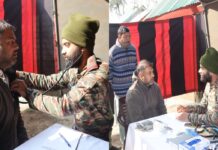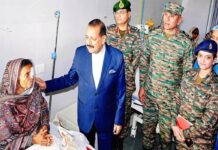“From Ayushman Bharat to AIIMS and mental health initiatives, the UT is setting national benchmarks in accessible, quality healthcare.”
By Zahida Parveen
X: @the_news_21
Srinagar: The health sector in the Union Territory of Jammu and Kashmir has undergone a significant transformation in recent years, driven by visionary leadership and strategic reforms by the Health and Medical Education Department (H&MED).
The focus on accessibility, digital integration, medical education, and infrastructure development has redefined the healthcare landscape, ensuring better services and improved well-being for the people of the UT. One of the most transformative initiatives has been the implementation of Ayushman Bharat–Pradhan Mantri Jan Arogya Yojana (AB PM-JAY) and its local extension, AB PM-JAY SEHAT.
As of March 2024, over 85 lakh Golden Health Cards have been issued, providing universal health insurance coverage of ₹5 lakh per family annually. While AB PM-JAY covers only the economically weaker sections in most parts of India, Jammu and Kashmir is the only region where every resident is covered, making it a pioneering model of healthcare equity.
With 251 empaneled hospitals, beneficiaries receive cashless secondary and tertiary care services. The rollout of the Ayushman Bharat Digital Mission (ABDM) in July 2022 further strengthened digital healthcare. Over 88 lakh ABHA (Ayushman Bharat Health Account) IDs have been created, enabling secure and real-time access to health records and facilitating smooth interaction between patients and healthcare providers.
A key innovation under ABDM is the Scan & Share Queue Management System, which uses QR codes for OPD registrations across district hospitals and CHCs, reducing wait times and improving service delivery. Medical education in J&K has seen tremendous growth. Since 2019, MBBS seats have doubled, and postgraduate and DNB seats have also increased. Seven new medical colleges have been established, raising the total to eleven,
In addition to two AIIMS at Vijaypur (Jammu) and AIIMS Awantipora (Kashmir). Prominent institutions now include two state cancer institutes, bone and joint hospitals, mental health institutes, and the upcoming GMCs at Handwara and Udhampur. Ten new Nursing Colleges are being equipped with faculty and staff, and the government is expanding paramedical and B.Sc. Nursing courses to further strengthen human resources.
To improve mental health care, the launch of Tele-MANAS, a 24/7 helpline based in Srinagar, and an AI-powered Chabot has helped reduce stigma and ensure timely counselling in remote areas. Meanwhile, ASHA workers, numbering over 13,500, and newly recruited Community Health Officers (CHOs) continue to bridge gaps between communities and institutions.

ASHAs were recognized by the World Health Organization (WHO) for their exemplary work at the grassroots level. The government has accelerated infrastructure development by initiating over 500 projects worth ₹7,000 crore. These include upgrades to district hospitals, CHCs, and PHCs.
The AIIMS OPD at Awantipora is scheduled for inauguration this year. Furthermore, 468 kanals have been earmarked for establishing “Medi-cities” in Jammu and Kashmir, which will host medical colleges, AYUSH centres, pharma hubs, and super-specialty hospitals. To ensure emergency preparedness, oxygen generation plants were set up in 37 hospitals at a cost of ₹223.80 crore, making the UT self-reliant in oxygen supply.
Under the “Save Life Jammu” initiative, model emergency rooms have been established at various healthcare levels. Equipped with modern tools, these units are backed by the 102 and 108 ambulance services to enable timely care and referrals. Advanced surgical services like total knee and hip replacement, laparoscopic surgeries, and ovarian cystectomies are now being conducted even at the CHC level, a rare achievement in India.
The Government Hospital Gandhi Nagar in Jammu has set a benchmark by becoming the first district hospital in North India to offer registered palliative care services. Looking ahead, the government is set to double funding for equipment and machinery to ₹400 crore. Three Cath Labs will be established in North Kashmir, Pir Panjal, and Chenab Valley, with a ₹45 crore outlay.
Over the next three years, MRI and PET scan services will be introduced in all new GMCs, while CT scan facilities will be extended to all district hospitals with a ₹110 crore allocation. Dialysis services will be provided in all 83 SDHs and CHCs, with ₹16.80 crore allocated for 40 new centres.
The government is also investing in AI-based diagnostics, with plans to distribute 100 portable X-ray machines worth ₹16.50 crore to district and sub-district hospitals. A 250-bedded Mother and Child Care Hospital (MCCH) at Anantnag is under construction at an estimated cost of ₹86 crore. To promote telemedicine, the government will integrate teleconsultations, e-prescriptions, remote monitoring, and AI tools into routine services.
The SEHAT App, to be launched soon, will provide teleconsultation, emergency support, ambulance services, medicine delivery, and real-time updates on preventive health measures—all integrated with AB PM-JAY SEHAT for seamless insurance access. To strengthen medical research and emergency care, ₹10 crore has been earmarked for research, and ₹7 crore each for GMC Jammu and Srinagar to establish Emergency Medicine Departments.
An additional ₹32 crore has been set aside for maintenance of oxygen plants, lifts, toilets, and ramps. The government is also setting up a Government Homoeopathy Medical College in Kathua with a budget of ₹52 crore and will soon operationalize the Modern Drug Testing Laboratory there. Under the Health Care Investment Policy (HCIP), private investment in healthcare will be encouraged to build state-of-the-art infrastructure.
In addition, under PM ABHIM, 13 Critical Care Blocks, 111 Block Public Health Units (BPHUs), and 10 District Public Health Labs (DIPHL) are nearing completion. Linear Accelerators (LiNAC) for cancer treatment will be installed at GMC Jammu and SKIMS Srinagar. Efforts to achieve TB-free status and improve maternal health care are also underway. Meanwhile, combating drug abuse remains a top priority.
De-addiction centres have been established in all 20 districts, and 377 Panchayats have been declared Nasha Mukt. Awareness campaigns and strict enforcement are key strategies in the fight against substance abuse. In 2025–26, the Health and Medical Education Department has been allocated ₹1,750.50 crore in capital expenditure, a significant increase of ₹643.71 crore from the previous year.
This budget will support infrastructure, diagnostics, and equitable health access across the UT. With strong political will, strategic investments, and people-centric initiatives, Jammu and Kashmir’s healthcare model is emerging as a beacon for other states—showing how digital innovation, universal insurance, robust infrastructure, and a skilled workforce can create a healthier, empowered society.
About the Author: Zahida Parveen can be contacted on email at – Zahraparveen06@gmail.com







can you get generic clomid prices cost cheap clomid online where can i buy generic clomiphene price clomid pregnancy buying clomiphene can you buy generic clomid prices what is clomiphene medication
I am in point of fact delighted to gleam at this blog posts which consists of tons of of use facts, thanks towards providing such data.
This is the kind of literature I truly appreciate.
purchase rybelsus – cheap semaglutide 14mg cost periactin 4mg
order motilium 10mg generic – buy generic sumycin online flexeril pill
buy cheap inderal – buy generic plavix 75mg buy cheap generic methotrexate
buy nexium 20mg generic – https://anexamate.com/ order nexium 20mg for sale
coumadin us – https://coumamide.com/ hyzaar usa
how to get meloxicam without a prescription – https://moboxsin.com/ purchase meloxicam for sale
purchase amoxicillin for sale – https://combamoxi.com/ amoxicillin order online
purchase diflucan generic – click diflucan 200mg sale
cenforce over the counter – https://cenforcers.com/ order cenforce 100mg online
take cialis the correct way – https://ciltadgn.com/# compounded tadalafil troche life span
zantac 150mg brand – https://aranitidine.com/ order ranitidine generic
generic tadalafil tablet or pill photo or shape – https://strongtadafl.com/ generic tadalafil 40 mg
This is the description of content I have reading. este sitio
viagra 50 mg street price – https://strongvpls.com/ cheap viagra 50mg
The sagacity in this serving is exceptional. https://ursxdol.com/clomid-for-sale-50-mg/
The depth in this piece is exceptional. https://buyfastonl.com/
I couldn’t weather commenting. Well written! https://prohnrg.com/
This is the make of advise I find helpful. https://ondactone.com/simvastatin/
More articles like this would remedy the blogosphere richer. how can i get generic motilium without rx
This is the make of post I turn up helpful. http://forum.ttpforum.de/member.php?action=profile&uid=424431
buy dapagliflozin medication – https://janozin.com/ purchase forxiga online
purchase xenical without prescription – https://asacostat.com/# order xenical 120mg online cheap
I used to be able to find good advice from your content. https://Z42Mi.mssg.me/
This is the kind of post I unearth helpful. http://www.haxorware.com/forums/member.php?action=profile&uid=396498
You can keep yourself and your dearest by way of being heedful when buying panacea online. Some pharmacopoeia websites function legally and provide convenience, solitariness, sell for savings and safeguards for purchasing medicines. buy in TerbinaPharmacy https://terbinafines.com/product/dilantin.html dilantin
Greetings! Very useful suggestion within this article! It’s the crumb changes which will obtain the largest changes. Thanks a portion in the direction of sharing! buy phenazopyridine 200mg pills
I couldn’t resist commenting. Profoundly written!
Tham gia cộng đồng game thủ tại Go88 để trải nghiệm các trò chơi bài, poker phổ biến nhất hiện nay.
采用高效谷歌外推策略,快速提升网站在搜索引擎中的可见性与权重。谷歌外推
iwin – nền tảng game bài đổi thưởng uy tín, nơi bạn có thể thử vận may và tận hưởng nhiều tựa game hấp
Tham gia cộng đồng game thủ tại Go88 để trải nghiệm các trò chơi bài, poker phổ biến nhất hiện nay.
iwin – nền tảng game bài đổi thưởng uy tín, nơi bạn có thể thử vận may và tận hưởng nhiều tựa game hấp
kuwin sở hữu kho game đa dạng từ slot đến trò chơi bài đổi thưởng, mang đến cho bạn những giây phút giải trí tuyệt vời.
Với giao diện mượt mà và ưu đãi hấp dẫn, MM88 là lựa chọn lý tưởng cho các tín đồ giải trí trực tuyến.